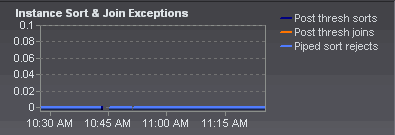The Instance Sort & Hash Join Exceptions graph tracks the total number of sort and hash joins that operated in less than optimal environments in the database during consecutive monitoring intervals. These sort and hash joins, known as exceptions, are likely to impact sort performance negatively. The totals are shown in the following series:
Post thresh sorts —Plots the number of sorts that were allocated less memory than the amount defined by the database SORTHEAP parameter. The database manager allocated this smaller sort heap to avoid exceeding the SHEAPTHRES value—the total amount of memory in the database committed to active sorts.
Post thresh joins —Plots the number of hash joins that were allocated less memory than the amount defined by the database SORTHEAP parameter. The database manager allocated this smaller sort heap to avoid exceeding the SHEAPTHRES value—the total amount of memory in the database committed to active sorts.
Piped sort rejects —Plots the number of non-piped sorts—that is, sorts that needed to route the final, sorted data through temporary files before sending it to the requester. Temporary files were used because the sort heap was not large enough to serve as both a sorting workspace and a temporary storage location for the sorted data.
